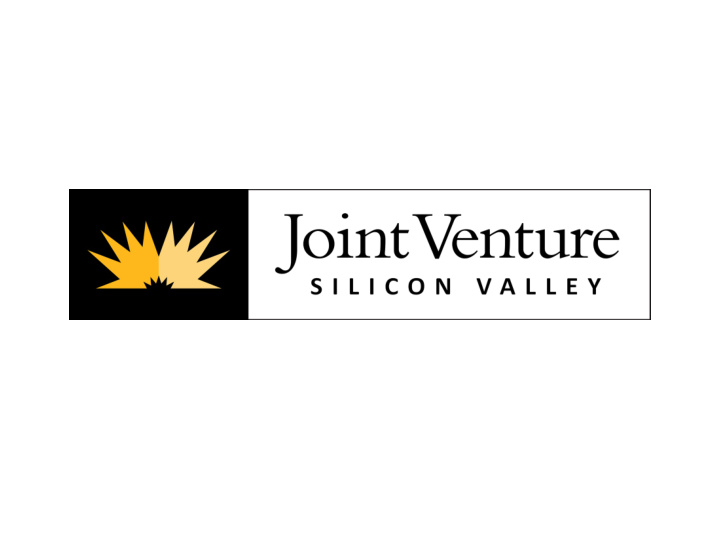



Natasha Ernst, Director Wireless Communications Initiative natasha@jointventure.org • Who We Are • Why We Are Necessary • How We Solve Problems • What We Are Doing • Where We Are Going
Who We Are • A steering committee of the wireless industry and local governments • We convene to resolve contentious issues preventing infrastructure improvements • Our goal is faster, cheaper, and more wired & wireless broadband connectivity in Silicon Valley
Why We Are Necessary • Silicon Valley’s wireless coverage lags behind many other parts of the country • The iPhone 6 has more technologies than current wireless networks support • Local governments are often the “gate keepers” over aesthetics
Educational Awareness • Much confusion and misinformation about radio frequency • In 2014, the FCC Chairman Wheeler spoke at the Computer History Museum in Mountain View – “This fourth network revolution is the one you all here in the Valley are leading and will continue to lead” of equal importance to the printing press, the railroad and electronic communications that began with the telegraph
Growing Demand For Wireless Broadband People Wireless penetration in the U.S. now exceeds 104%, and 97% of consumers may choose from at least three carriers. Nearly 90% of households use wireless, and 39% are wireless only. Forty-five million Americans use mobile phones are their primary internet device; 10% of Americans using smartphones only. Data U.S. mobile data use doubled from 2012 to 2013 and will increase 650% by 2018. About 56% of all mobile data is data-intensive video. Smartphones are driving traffic increase: 49 times more than a basic handset. Tablet use generates 127 times more network traffic than a basic handset. Wireless Internet of Things (IoT) connections are expected to increase from 36 million in 2013 to 263 million in 2018. Source: CTIA 6
Increased Wireless Speeds 4G LTE v. 3G: 10 times faster 3G: 144 – 400Kbps 4G LTE: 5 – 12Mbps 7
Network Densification: Small Cells Once macro cells reach capacity, small cells (aka oDAS, pico, micro) must be used to increase capacity. Small cell antennas are shorter to avoid interference. Coverage areas are limited in size, but greatly increase high speed broadband. Handsets are only as good as the antenna they are talking to. 8
Infrastructure Coverage Objectives Different Types of Infrastructure have Type Max Users Radius Different Coverage Capabilities (miles) Macro Cells: Towers/Rooftops Micro Cells: Smaller Macro Cells Macro Cell 500 25.00 oDAS/Small Cells: Right-of-Way Micro Cell 200 0.800 iDAS/Small Cells/Wi-Fi: In-Building oDAS 75 0.333 Femto Cells: Consumer Homes Ways to Increase Network Capacity Small Cell 32 0.094 Upgrades to existing Macro Cells, oDAS, in-building DAS/Small Cells Wi-Fi 50 0.057 New oDAS/Small Cells New In-Building Systems/Wi-Fi Femto Cell 6 0.008 9
What We Have Done • Targeted key Silicon Valley cities to develop new local ordinances for cutting edge technology – Palo Alto: new DAS system – Los Altos: new ordinance – Mountain View: new process – San Jose: work in progress – Santa Cruz County: new guidelines • Provide annual educational seminars on changing federal laws
Small Cells & Backhaul in the Right of Way Fiber optic connectivity is necessary high speed backhaul. Small antennas, radios, and battery backup on poles 11
Small Cell/oDAS Technology: Antennas Antennas are identical for both: Panel Antenna “Cantenna” Quasi-Omni 12
Small Cell/oDAS Technology: Radios Radio form factors are similar: DAS: CommScope ION-M Alcatel Lucent RRH Alcatel Lucent Metro Cell 13
What We Are Doing • FCC Report & Order 14-153 – Decreased regulatory barriers for small cells and temporary towers – Upgrades & improvements to existing infrastructure – Clarification of “reasonable time” for local approval – Educational outreach for ordinance changes • CPUC Pole Attachment Rulemaking – Just and reasonable rates for pole top attachments • City of San Jose Streetlights – Frozen infrastructure in large geographic areas – Working with city staff & elected officials to find a resolution & aesthetic solutions
Underground Areas: Streetlight/Traffic Signals Streetlights and traffic signals are the best options in urban underground areas, but require an agreement with the jurisdiction (ideal fee $1000/annually) 15
Underground Areas: High Aesthetic Concerns Stealth poles are being manufactured for areas with high aesthetic concerns and no existing appropriate structures 16
Underground Areas: High Aesthetic Concerns High end residential areas are often the most challenging areas to cover. 17
Where We Are Going • We will be working with two national organizations on educational outreach for the new FCC regulations • We will continue to be an expert in the CPUC rulemaking • Expanded scope into wired broadband—AT&T, Comcast, etc. • Internet of Things
Internet of Things The Internet Will Vanish Google executive chairman Eric Schmidt: “It will be part of your presence all the time.” Wearables gain traction. Our homes become connected. Our cars drive themselves. Everything will run on wireless networks, which run on fiber. 19
Questions ?
Recommend
More recommend